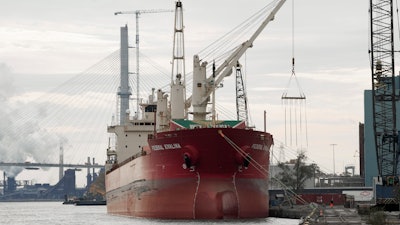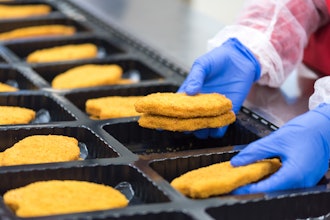
MINNEAPOLIS (AP) — A strike has shut down all shipping on the St. Lawrence Seaway, interrupting exports of grain and other goods from Canada and the United States via the Great Lakes to the rest of the world.
Around 360 workers in Ontario and Quebec with Unifor, Canada's largest private-sector union, walked out early Sunday in a dispute over wages with the St. Lawrence Seaway Management Corp. The strike has shut down 13 locks between Lake Erie and Montreal, bottling up ships in the Great Lakes and preventing more ships from coming in.
The St. Lawrence Seaway and Great Lakes are part of a system of locks, canals, rivers and lakes that stretches more than 2,300 miles (3,700 kilometers) from the Atlantic Ocean to the western tip of Lake Superior in Minnesota and Wisconsin. It carried over $12 billion (nearly $17 billion Canadian) worth of cargo last year. Ships that travel it include oceangoing "salties" and "lakers" that stick to the lakes.
It's the first time that a strike has shut down the vital shipping artery since 1968. Before the union walked out early Sunday, it said they were still "1,000 nautical miles apart on wages" despite several months of negotiations.
The strike was in its third day Tuesday when the Canadian government ordered both sides to return Friday to the bargaining table with a federal mediator in Toronto. U.S. officials are pushing the Canadian government and the Seaway corporation for a settlement.
"We have grain that feeds the world that's not moving. We have salt that goes on winter roads for safety that's not moving. We have iron ore for steelmaking that's not moving," said Jason Card, spokesman for the binational Chamber of Marine Commerce in Ottawa.
Management has asked the Canadian government to invoke a law to let ships carrying grain transit the system, but so far it has declined to intervene.
Jean Aubry-Morin, vice president of external relations for Seaway management, said Thursday that they're disappointed the talks have been dragging on. "We go to Toronto with the hope that this will change and that we can move forward and we can reach a fair and reasonable agreement," he added.
While Unifor recently won big increases from automakers, Aubry-Morin said the management company is a nonprofit corporation that doesn't have the means of the automobile industry.
Union officials did not respond to messages seeking comment but said in a statement, "Unifor will comply with the call to mediation and will continue to support our members on the picket line while talks take place."
Aubry-Morin said management knows of around 115 vessels in the St. Lawrence River and on Lake Ontario that are stalled. He said they didn't have figures for how many ships at sea might still be headed for the Seaway and the Great Lakes. But he put the total economic impact of the shutdown at $110 million ($153 million Canadian) per day.
The website MarineTraffic.com on Thursday showed numerous oceangoing ships were still inside the system. A major bottleneck is the closed Welland Canal in Ontario. Around 25 ships — salties and lakers — were anchored outside the Lake Ontario and Lake Erie entrances.
A U.S. Navy warship, the littoral combat ship USS Marinette, was supposed to leave Cleveland on Lake Erie on Monday, but remains stuck.
Other stranded ships included five at the major grain port of Thunder Bay, Ontario, on Lake Superior and two docked on the Detroit River between Lakes Huron and Erie. They won't be able to get past Lake Erie until the Seaway reopens.
Shipments within the four Great Lakes from Superior to Erie such as iron ore and coal can still go through.
John Jamian, director of operations for the Port of Detroit, said the strike has already affected eight ships that were bound for Detroit, ships carrying steel coils and slab steel for the auto industry and cement for the construction industry. And he said the number could grow.
"Bear in mind each one of those ships holds a lot of tonnage. Those ships are not coming into the system," Jamian said. "I know one is still in Europe with cargo and destined for Detroit. She's in a holding pattern."
The strike has also worried officials in the Twin Ports of Duluth, Minnesota, and Superior, Wisconsin, where the Cyprus-flagged, Polish-run Isadora departed Monday with a load of grain for Algeria. MarineTraffic.com showed that it reached Lake Erie on Thursday, but it can go no farther without a resolution.
"There's always a tremendous amount of shipping activity in the fourth quarter with it being peak harvest season, so this is an especially bad time of year for any interruption of seaway operations," said Jason Hron, spokesman for the Duluth Seaway Port Authority. "It really has cascading effects through the entire St. Lawrence Seaway-Great Lakes shipping system."
Hron said a few more salties that are already in the lakes are expected to arrive in the next few days, but what happens to them after they load and depart is an open question.
"North America's main inland trade corridor should not be used as a labor dispute pawn," Hron said. "And so Great Lakes ports and unions are urging the Canadian government to intercede directly and hasten a resolution to this dispute that reopens the seaway to full function immediately."






















